Omnichannel vs multichannel: A comparison of marketing strategies

Omnichannel and multichannel may sound like the same thing, but the truth is — these two marketing strategies are very different.
And while a business can succeed with either approach, you'll want to know about the critical differences before getting started.
To help you determine the right strategy for your business, we’ll walk you through all the differences between multichannel and omnichannel marketing.
To start, let’s look at the definitions of each approach.
What is multichannel?
Multichannel is the marketing strategy of using more than one channel to communicate with customers and prospects. This can include traditional channels like SMS, print media, or physical stores, and digital methods like websites, social media, mobile apps, and email.
However, these various channels aren’t necessarily integrated or coordinated with one another. As a result, the content and style of each channel may be different.
For example, your Facebook ads may have a completely different look and feel from your email campaigns. And since each channel operates independently in multichannel, customers must go to that specific channel to find the information they want.
What is omnichannel?
Omnichannel is a marketing strategy that integrates and coordinates all communication channels to create a seamless, unified experience for customers.
Like multichannel, omnichannel also uses multiple channels for customer engagement. But unlike multichannel, all those channels are connected with each other to deliver a consistent message and unified experience across all touchpoints.
For instance, if a customer visits your website, they see the same core message presented in a similar language and visual style as in your email newsletter, Facebook ads, or in-app messages.
Effectively, with omnichannel, a customer can move between all channels in their journey seamlessly. No matter what channel they use, they see the same unified message with the same branded look and feel.
How to develop a scalable, cost-effective omnichannel support strategy
Multichannel vs omnichannel: What’s the difference?
Omnichannel and multichannel both use more than one channel to engage customers, but there are a few key differences between these two strategies.
1. Level of integration
The first difference between omnichannel and multichannel is whether you integrate and coordinate the various channels used for customer engagement.
Multichannel marketing uses multiple channels to promote a product or service, but those channels may not be seamlessly integrated.
Omnichannel marketing also uses multiple channels, but integrates all those channels into a seamless, unified experience for customers.
2. Focal point
A key difference between multichannel and omnichannel marketing is their point of focus.
Omnichannel marketing is a customer-centric approach. It focuses on the needs of the customer, using all available channels to provide a smooth, holistic experience across the board.
Multichannel marketing is a product-centric approach. It focuses on promoting a product or service using more than one channel, optimizing the impact of each channel separately.
Here’s a quick comparison chart between multichannel vs omnichannel:
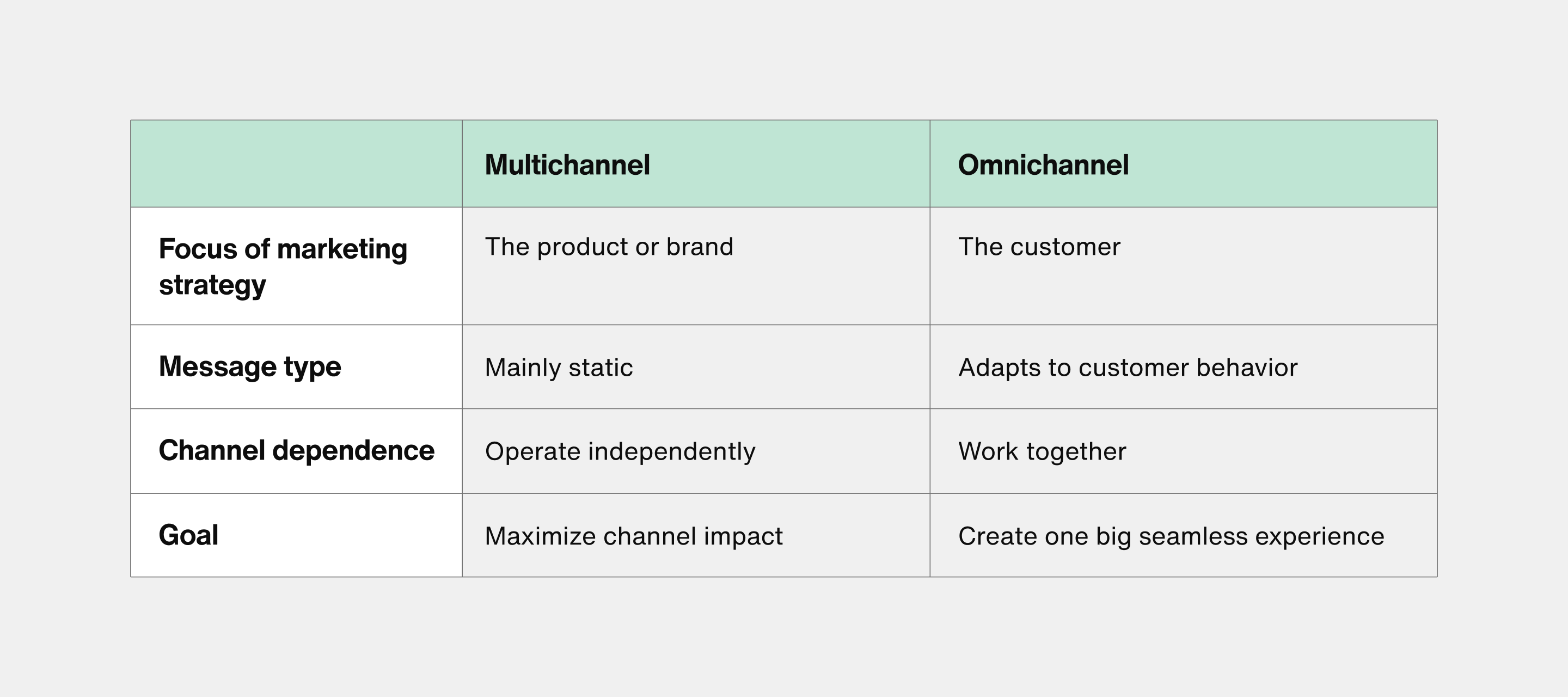
Basically, omnichannel marketing is centered around the customer. The main focus is the customer, so channels are coordinated to deliver a personalized experience at every step.
User data is integrated in an omnichannel strategy, serving to personalize and adapt the journey to the preferences and behavior of each individual in the moment. This allows the customer to access information from any channel, and enjoy a richer, more fluid journey with the brand.
For example, if a customer visits your website, they see the same key message and branding as in your email or social media. Or, if they use an AI chatbot for customer support and escalate the ticket to a call, they won’t need to repeat the information given to the chatbot.
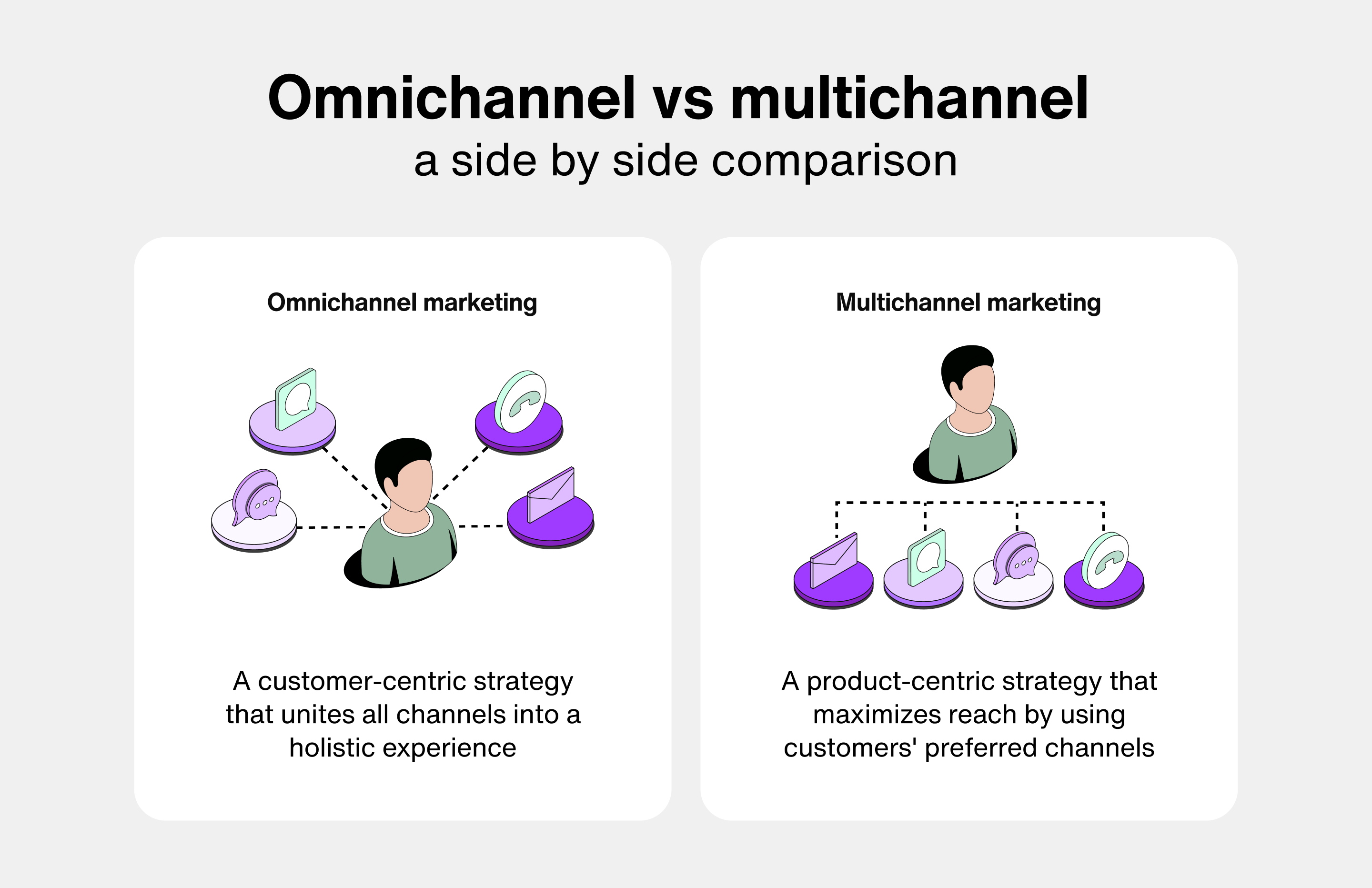
3. Quality of customer experience
Since everything revolves around the customer in omnichannel marketing, the experience is richer and more consistent than with multichannel.
This consistency makes the journey more convenient for customers, who generally want the ability to engage seamlessly with brands across multiple channels.
In the digital age, when customers move between multiple touchpoints before making a purchase, a brand that shows up at every step has a better chance of earning their business.
On a deeper level, consistency shows the customer that your business has the resources and awareness to attend to small details. This suggests they can trust your business to be reliable. As this trust grows, it can transform into loyalty, which leads to more purchases, positive reviews, and higher customer lifetime value.
How does multichannel marketing work?
The goal of multichannel marketing is to maximize reach and increase conversions by engaging customers at their preferred channels and touchpoints.
This means you’ll develop marketing strategies for each channel, without making an attempt to integrate these strategies.
For example, you might have a website, email newsletter, and a Facebook account to engage customers — without creating a cohesive experience across those channels.
Instead, you’ll play to the strengths of each separate channel. There might be a common message or value proposition, but there’s no data shared between channels, so it’s ultimately a siloed approach.
How to start multichannel marketing
If you want to develop a multichannel marketing strategy, the typical steps include:
Researching and identifying your target audience
Creating a buyer persona for your ideal customer(s)
- Choosing the most relevant channels to reach the target audience, such as:
Email marketing
Social media
Content marketing
Retail storefronts
Paid ads
Tailoring a marketing messaging to each channel
Tracking the performance of each channel separately
Optimizing the strategy of each channel
What communication channels do modern customers prefer?
How does omnichannel marketing work?
Omnichnanel aims to engage customers at all relevant touchpoints in the customer experience, from top of the funnel to post-purchase. It involves orchestrating those channels, all working synergistically to advance the customer journey on any channel.
Here are a few omnichannel marketing examples that illustrate how omnichannel works:
A customer is retargeted on Facebook for a product they abandoned in their online shopping cart
A customer is directed to a personalized landing page after opening a targeted email for a product they previously viewed on social media
A customer clicks a display ad but doesn’t complete the purchase, so they receive a push notification for a limited time offer in the brand’s mobile app
As you can see, omnichannel marketing involves integrating a variety of channels, all working in unison to deliver a holistic experience for customers.
Importantly, omnichannel also integrates customer data into a unified view of all interactions across the journey.
By synchronizing customer data across channels in real-time, omnichannel allows customers to move between channels without friction. Meanwhile, each channel is feeding data into a unified, 360-degree view of customer behavior across channels.
“We’re in the age of omnichannel, where there’s no email versus anything. There’s no SMS versus anything, social versus anything... a really important point is to know your audience, and then also to know their receptiveness to messaging in a particular channel.”
Chad White, Head of Research at Oracle Marketing Consulting

How to build the perfect mix of mobile customer communication channels
Multichannel vs omnichannel marketing examples
Now that we’ve defined omnichannel and multichannel, let’s look at some omnichannel marketing examples and multichannel marketing examples from top brands.
Multichannel marketing example: Costco
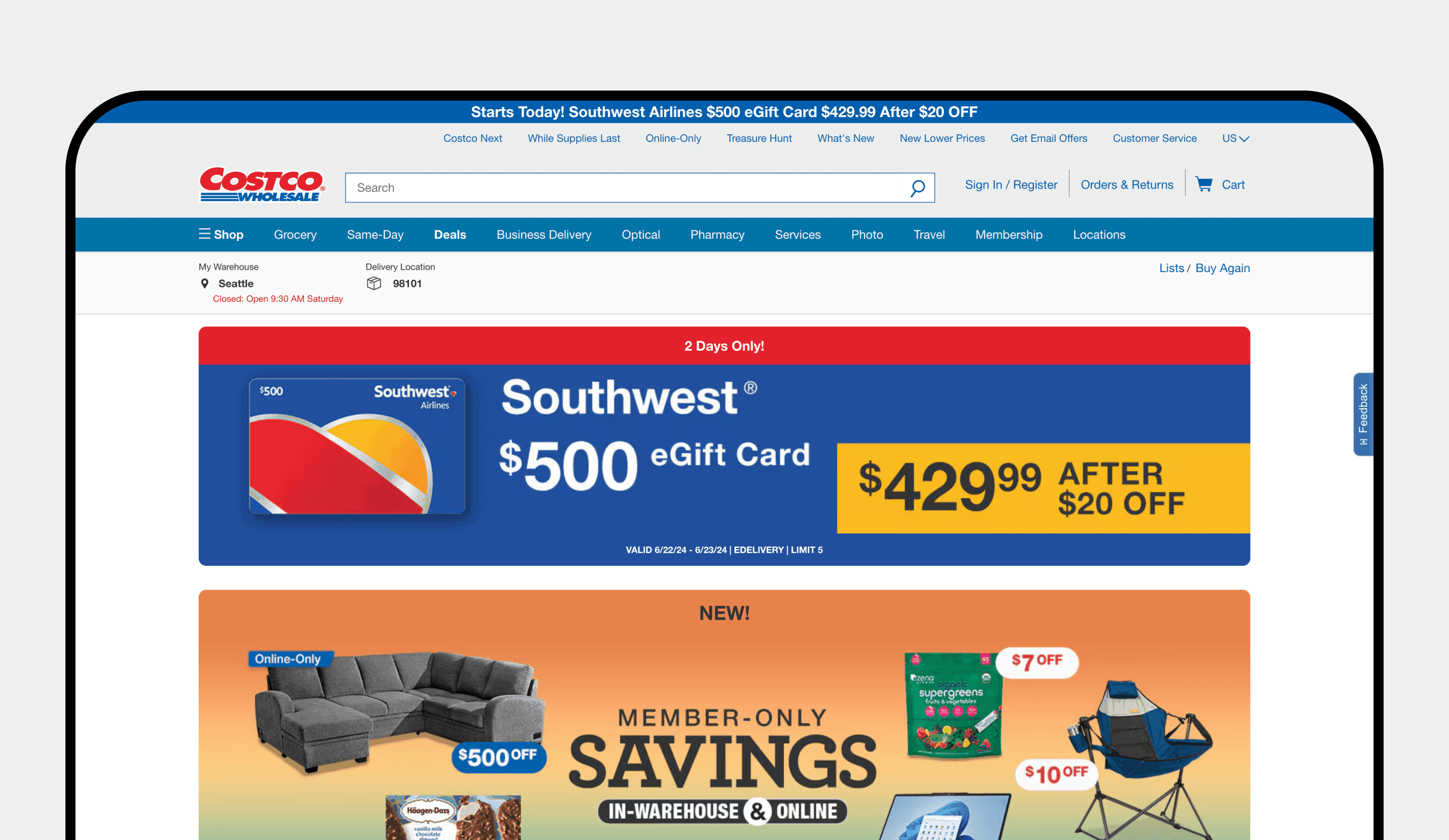
Costco is one of the largest bulk retailers in the world, and a great example of using multiple independent channels to reach and serve customers.
The retailer uses its physical stores, website, and mobile app to sell products to a price-conscious audience. Costco shoppers have strong preferences about their go-to buying channel, and which they channel they use to access discounts, and these segments tend to fall along generational lines.
In turn, Costco shares a mix of coupons and announcements via email, social media, and direct mail — but each channel caters to a slightly different audience. Since shoppers have their chosen lane, there’s no attempt to create a seamless experience between the channels.
Costco uses email to blast out offers and updates, and stay top of mind across the widest swathe of its audience. For those who don’t use digital marketing, like older generations, there’s direct mail. Social media like Facebook and Instagram allow Costco to reach a younger audience, while growing an online community.
In Costco’s multichannel strategy, each channel promotes a similar set of products, news, and content, but always in the style of each distinct channel that caters to a different audience.
Omnichannel marketing example: Starbucks
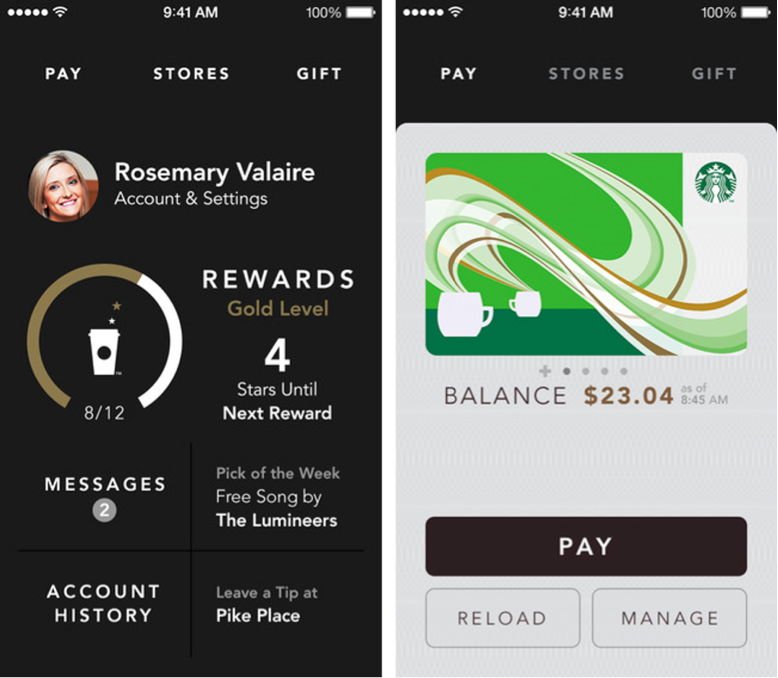
Starbucks is considered to have one of top omnichannel experiences on the market, thanks largely to its integrated mobile app and rewards program.
With the Starbucks Rewards app, the users’ order history, preferences, and loyalty reward points are all synced across the various devices and the physical stores. Users can check and use their rewards balance in the app, in-store, or online at any time, and instantly see changes in their reward points profile updated in real-time across all channels.
By collecting and analyzing user data, Starbucks is able to provide personalized experiences in-store, online, and in-app. This can include suggesting favorite drinks, offering recommendations, and remembering a customer's name and order across channels.
With flexible ordering and rewards management from anywhere, the transitions between in-app and in-store are seamless for users. This added layer of convenience sets the Starbucks omnichannel experience above competitors, and helped the app gain a whopping 30 million users.
Omnichannel marketing example: Sephora
Sephora excels at blending online and in-store experiences with its omnichannel retail marketing strategy.
The beauty brand has seamlessly integrated its physical stores, ecommerce, mobile app, social media, and loyalty programs, creating a cohesive and engaging experience that keeps customers coming back for more.
However customers want to shop, the Sephora in-app loyalty program allows customers to collect, review, and purchase products added from any channel. In-store shoppers can access previously viewed or purchased items at in-store kiosks called The Beauty Bag, and even try on products using AR/VR screens before buying.
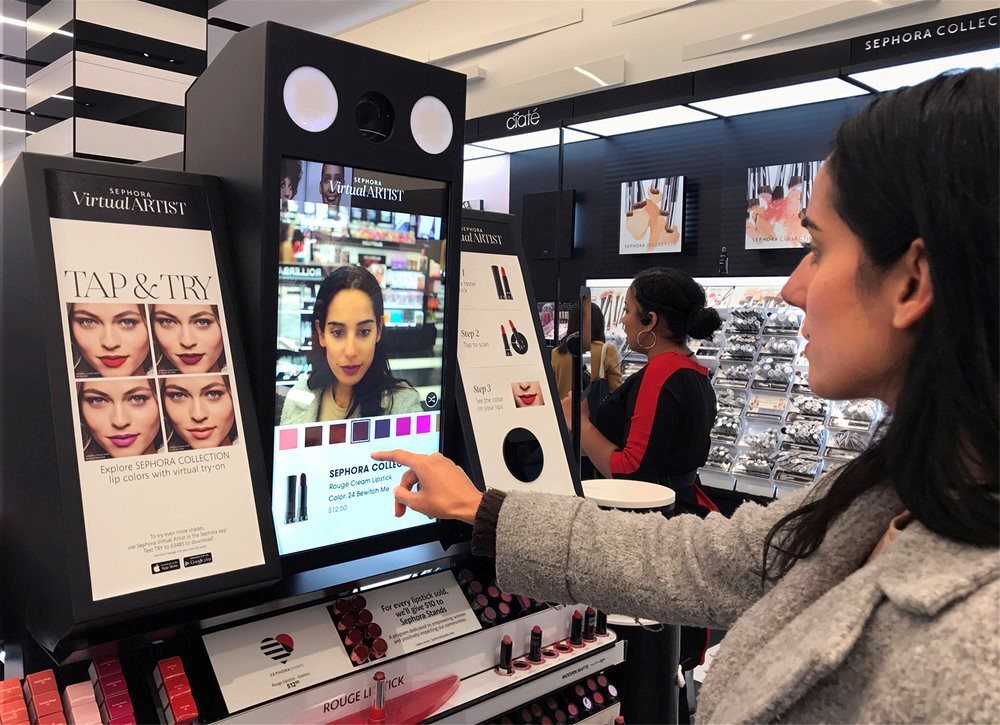
The brick-and-mortar experience is consistent with what’s online, only improved by free makeovers, samples, and well-informed salespeople. The loyalty program helps to connect the in-store and online experiences, providing full visibility of order and shopping history from anywhere to effectively drive purchasing.
In coordination with email marketing, the brand also uses in-app notifications and push notifications to deliver personalized recommendations that drive repurchasing and reduce cart abandonment. Meanwhile, social media is where tips, tutorials, and trends can be found, helping the brand drive engagement.
Overall, Sephora has all bases covered with its omnichannel experience, providing a cohesive and enchanting experience that fosters long term loyalty and advocacy.
How to develop a scalable, cost-effective omnichannel support strategy
Multichannel vs omnichannel strategy: How to choose?
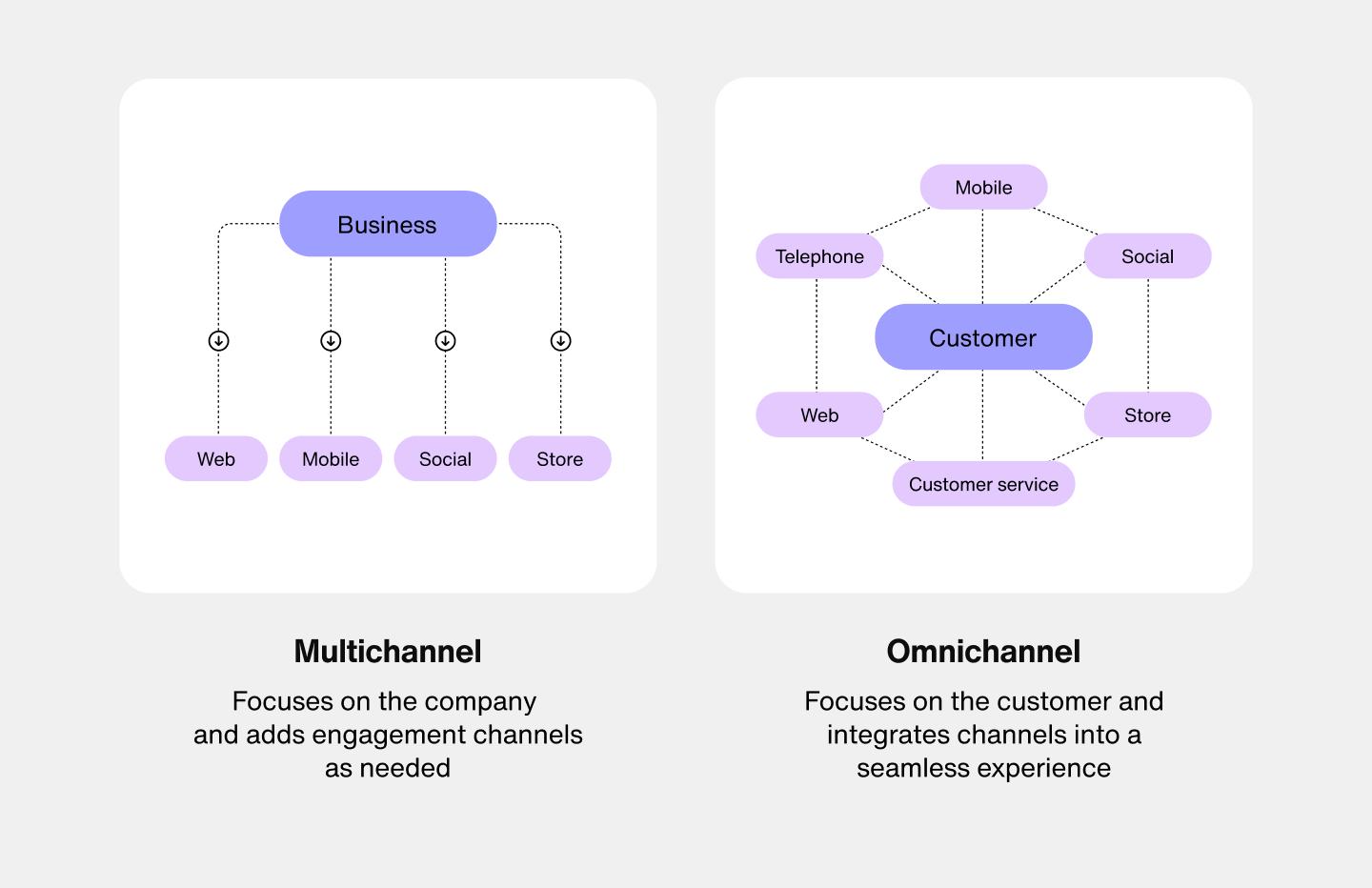
With its seamless user experience, omnichannel marketing might seem like the obvious choice for a business — but there’s more to consider.
Fact is, businesses have found success with both omnichannel digital marketing and multichannel marketing. So it’s important to choose the approach that best suits your resources, goals, and customer expectations.
When should you choose multichannel?
Multichannel is a good choice if you want to expand your reach or achieve a particular business objective.
For instance, if you want to add SMS marketing to your marketing mix. Or drive engagement for your loyalty program using a mix of social media, in-app notifications, and push notifications.
The main advantage of multichannel is that every channel functions on its own, so stakeholders have the flexibility and autonomy to focus on growing their distinct channels.
You’ll set up a funnel for each channel and optimize them respectively, without having to orchestrate journeys across channels or consider each variation of audience. It’s an easier strategy to start with, and a common stepping stone to omnichannel marketing strategies.
Multichannel is the default marketing strategy for many businesses, especially those with limited resources.
After all, it may be difficult for a smaller brand to launch a fully comprehensive omnichannel strategy. Nor is it necessary for many brands to launch a website, email newsletter, SMS marketing, and social media campaigns all at once.
Instead, it can be better to initially focus on particular channels like mobile app marketing or social media, and integrate them all later. To this end, growing businesses do have the option to implement omnichannel capabilities in manageable chunks.
For example, Sendbird’s customer messaging platform allows a business to easily add key mobile marketing channels — SMS, in-app notifications, push notifications, WhatsApp — to the marketing mix via a unified API. Or, if you want to turn your mobile app into a marketing channel, our integrations with Braze, CleverTap, and more make this simple.
In the end, while multichannel is less complex than omnichannel, it still requires investment to keep customers happy. You’ll need the right technology to scale multichannel marketing, like marketing automation, to help you grow without delivering a fragmented experience.

How to build the perfect mix of mobile customer communication channels
When should you choose omnichannel?
Omnichannel is the way to go if you want to level up your customer experience and invest in your brand.
For many businesses in today’s competitive landscape, it simply takes more than a coupon code to ensure customers pick you over competitors, and omnichannel can be the differentiator.
According to McKinsey, 90% of US consumers say they plan to continue switching brands in search of a differentiated experience.
That said, omnichannel marketing is more resource-intensive than multichannel, as keeping all channels working in tandem requires the help of automtated software for omnichannel marketing or omnichannel customer service that can integrate and orchestrate all channels, interactions, and their data.
But with benefits like improved customer engagement, increased retention, and greater brand loyalty — omnichannel offers a big payoff if you’re ready to level up your customer experience.
Once you’ve decided on the right approach for your business, the next step is to look for omnichannel software and marketing tools that can help you implement it. This includes an omnichannel AI customer experience platform like Sendbird, in addition to solutions for marketing automation, data management, and other operations.
Sendbird, for example, is a one-stop solution for omnichannel mobile marketing. You can easily integrate all the key mobile marketing channels into your mix, including SMS, in-app notifications, mobile push notifications, and WhatsApp. With intuitive software and seamless API integration with any stack, Sendbird offers the mobile portion of omnichannel without the heavy lift.
Benefits of omnichannel marketing
By integrating and synchronizing channels to deliver a consistent experience for customers, omnichannel can deliver the following benefits:
Optimal customer experience: Omnichannel creates a cohesive, responsive, and often personalized journey across channels that consumers say they prefer.
Improved customer engagement: Omnichannel engages across more touchpoints with effective personalization that can drive higher rates of engagement than multichannel.
Enhanced customer retention and loyalty: A smooth user experience leads to satisfaction which in turn fosters loyalty among customers who feel valued and looked after.
Increased revenue: Omnichannel customers tend to have higher conversion rates, as the integrated approach keeps your brand top of mind and makes it easier to complete a purchase.
Competitive advantage: Omnichannel can differentiate a business from competitors using a multichannel approach, making your brand more attractive to customers who value a cohesive experience that can better meet their needs.
Greater customer insights: Omnichannel marketing offers a unified view of customers, using data and analytics integrated across the journey to inform decision-making, personalization, and innovation.
Challenges of omnichannel marketing
For all its benefits, omnichannel in marketing requires careful planning, resources, and ongoing effort to handle implementation and maintenance, which can include:
Integration: Integrating the various systems like CRM, marketing automation, and inventory management can require an investment in technology and infrastructure to sync data and operations across all channels.
Data management and privacy: Omnichannel generates vast amounts of data, which can be a lot to manage and analyze without data management systems.
Costs: Implementing an omnichannel strategy can require a large initial investment in technology, infrastructure, and process changes, plus ongoing maintenance to monitor, update, and optimize systems.
Compliance: Companies must comply with data privacy regulations to ensure that all data is stored and handled securely, which can require dedicated compliance resources, especially when marketing to consumers in different global regions.
Consistency and quality control: Providing a consistent experience across channels can be tricky, as different channels may be managed differently (e.g., in-store staff vs online support), so quality control processes may be needed.
Given these challenges, and the steep investment for a full omnichannel marketing strategy, growing businesses may prefer to selectively integrate omnichannel capabilities into their stack rather than going all in.
For instance, Sendbird allows marketing teams to seamlessly add key mobile marketing channels to their mix like in-app notifications, SMS, mobile push, and WhatsApp using a unified API that simplifies stack integration. Or, AI chatbots are a channel that can improve the customer experience all by itself, and even help with lead generation.
These capabilities are integrated seamlessly as new channels within existing systems such as Braze or Shopify, allowing marketing teams to engage customers on key channels without the cost and maintenance of a full switch to an omnichannel marketing strategy.

How to build the perfect mix of mobile customer communication channels
How to start omnichannel marketing
While omnichannel strategies can significantly enhance the customer experience and drive growth, creating an omnichannel experience isn’t an overnight process.
To give you an idea of what’s required, here are the basics of starting an omnichannel marketing strategy:
Unify your customer data to create one source of truth
Create customer personas with a deep understanding of preferences and needs
Map the customer journey to see all channels
Create a core, unified message that resonates across channels
Tailor content and CTAs for each channel from the core message
Consider building a mobile app, both as a new channel and to enhance the effectiveness of others
Integrate the omnichannel software and platforms for each channel
Launch cross-channel campaign and monitor engagement
Measure performance and optimize

How to build the perfect mix of mobile customer communication channels
Multichannel vs omnichannel ecommerce
For ecommerce businesses, it’s vital to give customers various ways to encounter your product and make a purchase. If it’s easy for customers to discover and purchase your products, they’re simply more likely to buy once, and again in the future.
Omnichannel ecommerce allows customers to switch between platforms effortlessly, as all their data, preferences, and buying history are all synchronized across channels.
This facilitates the buying process, creating a streamlined, personalized shopping experience that can span from social media to email to AI chatbots for ecommerce on your website.
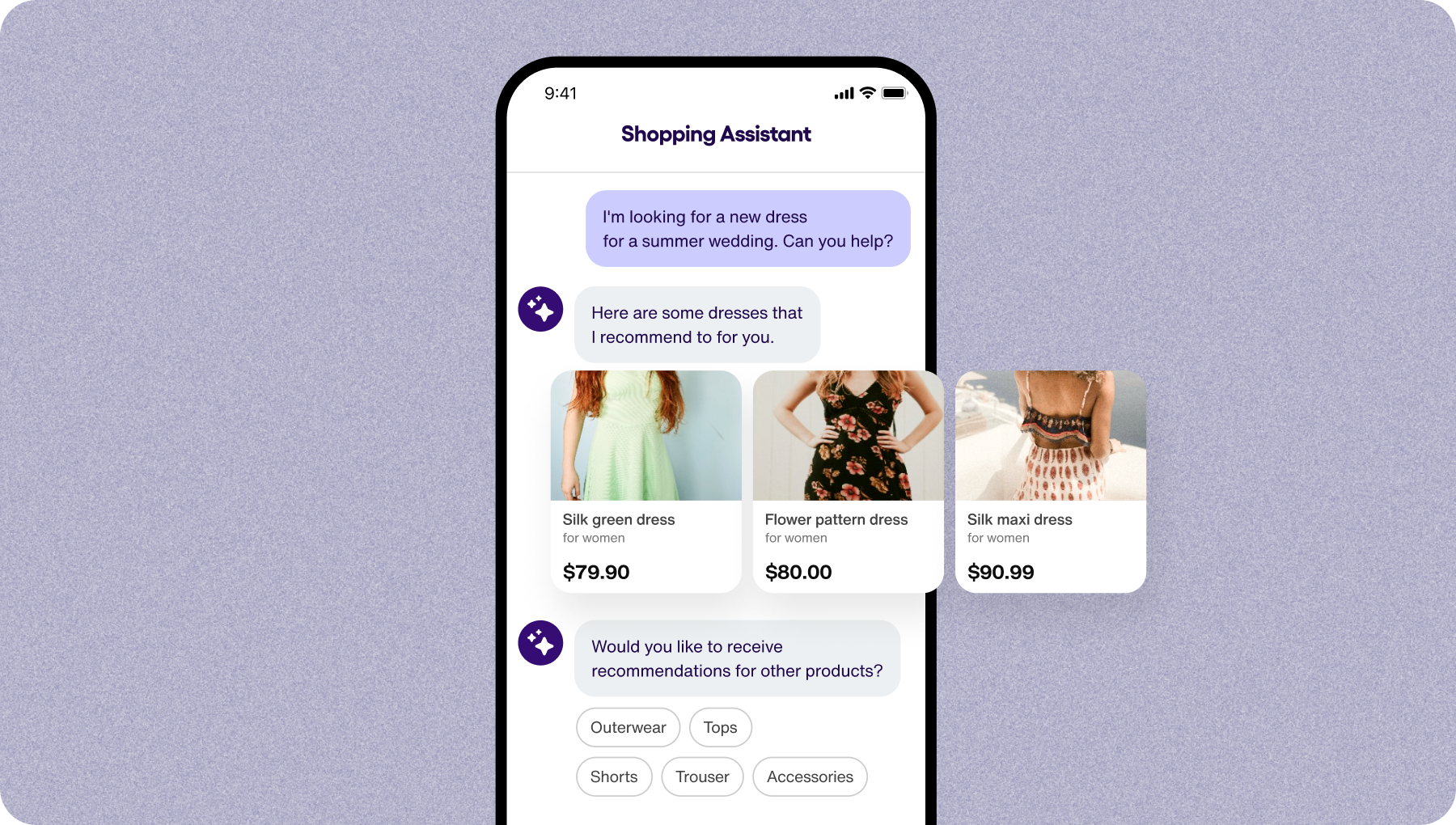
By comparison, multichannel may result in an inconsistent customer experience. While there are multiple ways to engage, there’s no continuity between channels, which can lead to frustration. For example, inventory levels may be inaccurate and customers may be shown products they’ve previously purchased.
Multichannel vs omnichannel customer support
Multichannel support allows a customer to access different channels to initiate a support request. Omnichannel customer support, by contrast, offers a seamless experience by integrating multiple channels.
Omnichannel allows a customer to contact support using their preferred channel, such as email, phone, social media, live in-app chat, or AI chatbots for customer service. What’s more, the customer can switch to a different channel without losing the context of the previous interaction.
For example, an omnichannel chat support platform like Sendbird Desk enables support agents to pick up where an AI chatbot left off, for a smooth transition and user experience without a redundant exchange of information.
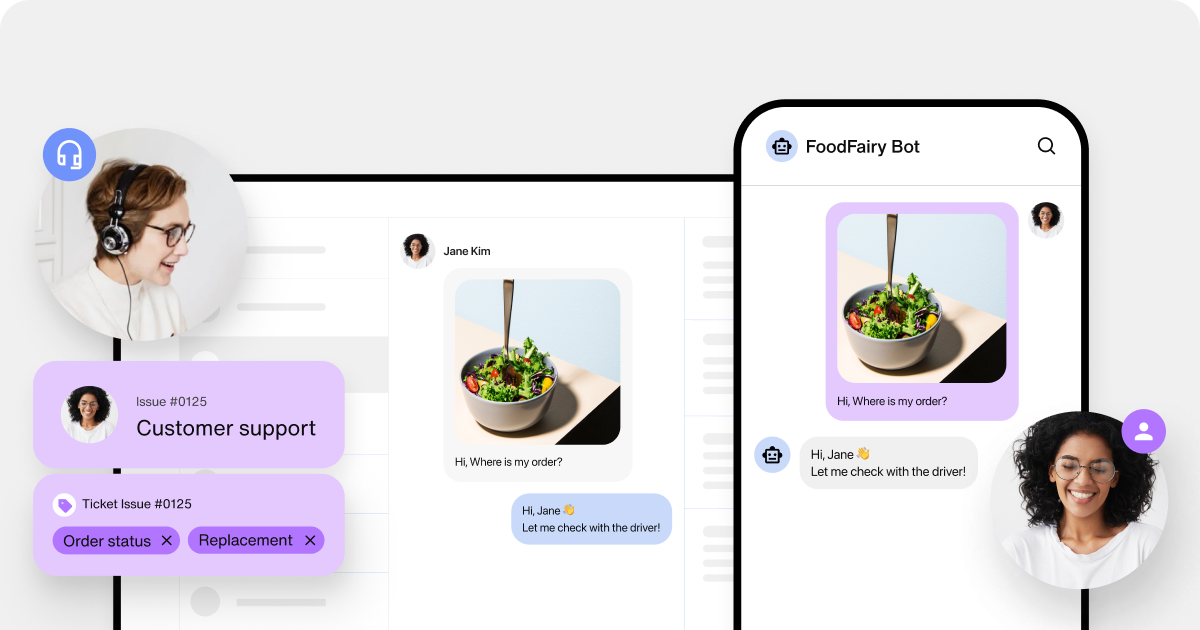
Ultimately, omnichannel customer support can both expedite issue resolution while also increasing customer satisfaction.
How to engage and retain more users with in-app notifications
Multichannel vs omnichannel retail
Multichannel retail focuses on delivering information to customers using a range of channels, as each channel can increase the chance a customer will make a purchase. Each channel has its own message that’s aligned with the customer expectation for that channel. However, these channels don’t work synergistically together.
Omnichannel retail marketing, on the other hand, focuses on making the customer the center of the business strategy. For example, customers can begin shopping on social media, ask product questions via using mobile in-app chat, then complete a purchase on the company website.
It’s important for a business to align its channels, paying special attention to the experience that employees deliver in-store to what’s online. By giving customers more access to products, news, and offers as part of a cohesive experience, omnichannel retail can lead greater engagement, loyalty, and purchasing.
Omnichannel vs multichannel: Final thoughts
With 9 in 10 consumers saying they expect a consistent experience from a business, omnichannel marketing is becoming a competitive advantage in our fast-paced digital landscape.
Though multichannel has been the default way for businesses to expand their reach (prior to the internet, anyway), there are many benefits to delivering a seamless and consistent customer experience.
Using omnichannel messaging software, businesses can better meet customer expectations, driving greater engagement, conversions, and loyalty. Meanwhile, omnichannel brings in lots of data, helping you make data-driven decisions, drive personalization, and stay competitive.
That said, if you’re simply looking to expand reach and improve specific brand objectives, a multichannel strategy can help.
Whether you’re game for omnichannel or multichannel — if you want to add the essential mobile channels to your marketing mix — you’re in the right place.
With Sendbird, it’s easy to create, orchestrate, and engage customers at scale across mobile channels like in-app notifications, mobile push notifications, SMS, WhatsApp, and AI Chatbots.
Our G2-leading customer messaging platform simplifies integration with the entire stack via unified APIs, and offers intuitive software that’s easy for all teams to use.









